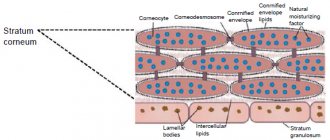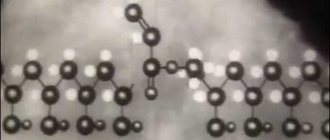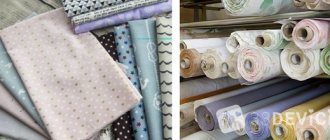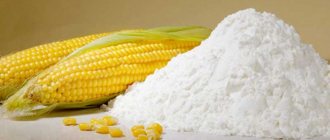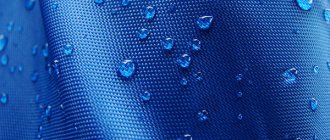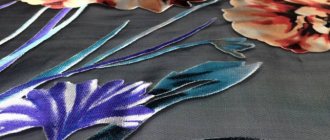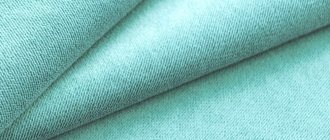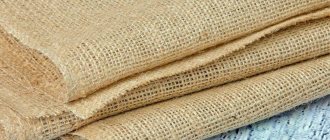Fabric Making Basics
Fabric is made from yarn, which in turn is made from fiber. The quality of the resulting fabric is highly dependent on the characteristics of the fibers.
Fibers are divided into natural and chemical, originating from natural raw materials or obtained as a result of chemical synthesis, for example, polymer fibers.
The entire technology is conventionally divided into three stages:
- Spinning;
- Weaving;
- Finishing.
Spinning
The basis of fabric production is spinning. It is a process that produces a long thread - a yarn woven from short fibers. This production process is carried out on a spinning machine.
The fibers produced by the mill are usually compressed into small bales. Then they are loosened and crushed using appropriate machines, while at the same time cleaning them from debris. The scutching machine produces canvas from threads, which is rolled into a roll.
The resulting canvas is then passed through carding surfaces covered with fine metal needles. At the exit, after carding, a sliver is obtained, which must be leveled on a draw frame, and then slightly twisted on a roving and twisting machine. After these operations, a roving is obtained.
On the spinning machine, the roving is leveled and drawn, then wound onto bobbins. A spinning machine for fabric production is serviced by spinners. Their responsibilities include eliminating yarn and roving breaks, changing bobbins and maintaining equipment.
Yarn is used to make:
- knitwear;
- sewing threads;
- non-woven and woven materials.
Production of textile materials
Textile materials
surround us everywhere.
Table linen is made from them:
tablecloths, napkins, towels, etc.
Bed sheets:
pillowcases, sheets, duvet covers.
They are used to make curtains, furniture upholstery, carpets
.
And most importantly, our clothes are made from textile materials.
To sew any product you need fabric. To make fabric, you need yarn (threads). The material from which yarn (threads) is created and then various products are called textile fiber.
Light industry group
Those
who produce fabrics and other products from textile fibers
are
called the textile industry.
Textile enterprises
According to the division of their work there are
spinning, weaving, spinning and weaving, dyeing and finishing.
There are enterprises that combine all these productions.
The textile industry is one of the oldest and largest branches of light industry.
All textile materials are made of fibers . There are two groups of textile fibers:
natural and chemical.
Natural fibers
are of plant and animal origin.
Chemical fibers
are divided into artificial and synthetic.
Natural textile fibers are created by nature.
Plants most often used to produce plant fibers are cotton and flax.
Cotton
is a perennial heat-loving plant.
Therefore, its cultivation began in hot countries - India, Africa, Mexico, Peru.
Now this plant is cultivated in more than 50 countries around the world.
Cotton
is a shrub up to one meter or more in height. After flowering, fruits are formed on the cotton bushes - boxes containing seeds covered with hairs.
Each seed develops from seven to fifteen thousand hairs. These are cotton fibers. Cotton fiber length is from 12 to 60 millimeters. The longer the fibers, the better quality yarn and fabrics are obtained.
After ripening, the boxes open and are collected manually or using machines.
From cotton procurement points, raw cotton is delivered to cotton gin plants
, where cotton is cleaned - the fibers are separated from bolls, seeds and various impurities.
The cleaned cotton is then pressed into bales and sent to spinning mills for further processing.
Cotton fibers are usually white or slightly cream in color. Currently, scientists have already developed varieties of colored cotton. Fabrics made from cotton fiber are easily dyed and can easily be finished in various ways.
Linen.
Flax fiber
is found in the stem of the flax plant.
Part of the flax stem is the bast, located under the bark. It contains bast fibers in the form of thin bundles. Therefore, the fibers are called bast.
Flax has been grown in Rus' since ancient times. This plant loves light, moisture, moderate heat, and is not afraid of light frosts.
There are several groups of flax:
long flax, curly flax and others. The longest fibers are obtained from fiber flax, since its stems reach a length of as much as 80-100 centimeters.
Ripe flax stems are pulled out of the ground along with the roots to maintain the length of the fibers. This process is called teasing.
Previously, it was done manually, but now with the help of flax combines and pulling machines.
Flax stems are freed from seeds on flax threshing machines.
Such peeled stems are called
straws.
The straws are soaked in ponds or special pools.
Soaked flax stalks are called trusta. The production of flax fiber from the stems of the plant is carried out at flax mills. There is a special technology
for separating fibers from the wood of the stem and further processing the resulting raw materials. The soaked stems are dried and mechanically processed. They are crushed and crushed to separate the fiber from the wood of the stem and other tissues. Then the flax fibers are bleached, since before this operation they have a light yellow color, turning into steel.
Flax fibers are very durable and strong
, are well colored, the best varieties have a silky sheen.
Of all textile products, the largest share falls on the production of fabrics. The process of making fabrics consists of several stages: spinning, weaving, finishing of fabrics.
In order to obtain a long and strong thread (yarn) from individual short fibers, they need to be connected and twisted. This process is called spinning.
Spinning
- is the creation of yarn (threads) from a fibrous mass by twisting fibers together.
Spinning is carried out in spinning mills
. Modern spinning mills are equipped with sophisticated mechanisms and machines. Fiber usually arrives at spinning mills compressed into bales. The fiber contains many impurities, the finest fibers are tangled and wrinkled. In this form, the raw material is of course unsuitable for spinning. Therefore, several more operations are performed, as a result of which the fiber is cleaned, straightened, separated into individual fibers, combed, and only then twisted into yarn.
The spinning technology is performed sequentially in several stages
on various machines (loosening, scattering, carding, belt, roving). The yarn manufacturing technology is completed on spinning machines, where the resulting yarn is wound onto paper cartridges (tubes) or wooden bobbins.
The process of making fabrics from yarn is called weaving.
The yarn enters the weaving workshop. Fabrics are produced on looms in the form of long strips of varying widths. Strong and smooth grained threads are stretched along the loom - they are called the warp.
A less strong and fluffy transverse thread is wound on the shuttle.
It is called a duck
.
When the weaving machine operates, the warp threads move apart. Between them a space is formed, which is called the pharynx. Then the shuttle inserts a weft thread through the shed. Along the edges of the finished fabric, a special device forms a thickening - an edge.
Fabrics with various weaves are made on a loom.
When weaving is formed, the warp threads are laid in a certain order - either above or below the weft ones. The warp and weft threads can be intertwined through 1, 2, 3 or more threads, after which the weaving order is repeated. The smallest number of threads after which the weaving order is repeated is called repeat. In fabrics, rapport is distinguished by warp and weft.
The most common weaving patterns
– plain, twill, satin and satin.
Plain weave is the simplest.
In it, the weft thread is intertwined with the warp thread in a checkerboard pattern. The surface of fabrics with this weave is smooth and matte. The face and back are the same. The fabric itself is durable. Many fabrics have plain weave: chintz, calico, some wool and silk fabrics. The plain weave is especially visible when examining gauze.
Fabrics with twill weave
differ from plain weave fabrics in appearance. They have clearly visible oblique stripes - fir-trees (ribbed), located from left to right. Wool fabrics have this weave.
Fabrics with satin and satin weaves
in appearance they are very different from the first two weaves, since on the front side they have a smooth shiny surface. Using this weave, cotton (satin) and silk (satin, lining) fabrics are created.
Fabric that has been removed from the loom is called gray.
It is ugly, hard, does not absorb water well and is not ready for use.
In the future, these tissues must undergo processing
– a number of finishing processes. They are bleached, treated with special solutions, dyed, patterned, starched, and ironed.
Whitening –
This is to give the fabric whiteness. Fabric that has been bleached is called bleached.
Special purpose fabrics
- waterproof, fireproof - impregnated and filled with special substances, special solutions.
Dyeing
- this is the dyeing of fabric in any color in a huge bath, which is filled with a dye. Fabric after such dyeing is called plain-dyed. If the threads were dyed before weaving, the fabric is called variegated.
Printing –
This is the application of a design to bleached fabric. This fabric is called printed.
As archaeological finds show, textile production arose in ancient times in Egypt, India, and China.
During excavations of ancient Egyptian pyramids, archaeologists found pieces of linen fabrics in the tombs. It is believed that cotton fabrics were first made in India, in Greece they were created from linen and wool, and China is considered the ancestor of silk.
When sewing garments, you need to be able to determine the direction of the grain thread in the fabric.
This can be done as follows:
· Along the edge: the grain threads go in the direction of the edge.
· By stretching: lobar threads stretch less than transverse threads.
· By type and strength of threads: lobar threads are smooth and strong, transverse threads are fluffy and less strong.
· By sound: with a sharp stretch (cotton) of the fabric along the lobar threads, the sound will be more distinct, along the transverse threads it will be muffled.
The fabric has a front and back side
. To make products you need to learn to distinguish between them.
The main features by which the front side is determined:
· Brightness of the picture. Printed fabrics have a brighter pattern on the front side.
· Minor fabric defects. On the front side, fewer nodules and fibers are visible.
· Weaving pattern (weaving of threads). In twill weave, the diagonal rib on the front side goes from the lower left corner to the upper right. And in satin and satin weave, the front side is smooth and shiny.
Lesson summary.
We learned: about the production of textile materials. We learned what groups textile fibers are divided into. We considered natural fibers of plant origin, such as cotton fiber and flax fiber. We looked at the process of making fabrics. And then we figured out how to determine the direction of the grain thread in the fabric and how to learn to distinguish between the front and back sides.
Synthetic yarn
For synthetic fabric production, a more complex technological scheme is used. A liquid and viscous spinning mass is obtained from the initial components. It goes into a spinning machine designed specifically for processing synthetic fibers.
The fibers are formed using special dies - this is a small metal cap with many small holes inside. Using pumps, the mass enters the die and flows out through small holes. The flowing streams are treated with special solutions for hardening.
The creation of synthetic fiber is also the spinning of this fiber. Depending on what the fabric is intended for and what quality is required, the number of threads twisted into one is calculated. After finishing, the threads are wound onto bobbins and sent for weaving.
Pros and cons of organizing fabric production
Attention! The main disadvantage in the garment industry is the heavy dependence on materials (up to 55%) and tools.
There is almost no textile industry in our country. But at the same time, there will be occupancy for the whole year, and not just for the season.
Due to the fact that the dollar exchange rate is rising, the number of customers interested in domestic products is increasing. This will be a good time to expand production.
Jute fiber
Own production is good because the entrepreneur is his own boss and can control everything.
Opening your own fabric production business will be difficult for someone who is just starting a career as an entrepreneur. You need to know what the fabric is made of, what tools are needed, etc. But if you avoid all the pitfalls, then success is guaranteed in Russia, since at the moment there are few such types of activities.
Weaving
The direct process of producing fabric from yarn is called weaving. The production equipment at this stage is maintained by weavers, who can service up to fifty automatic looms.
On a mechanical machine, the weaver replaces empty bobbins and eliminates thread breaks. The employee must know the requirements for the quality of fabric, the parameters of defective fabric and the reasons for the appearance of defects, measures to prevent and eliminate defects. Once the weaver has started the loom, it begins to combine the yarn into the resulting woven fabric.
Homeland of fabric
Nowadays, even a small child knows that a huge number of goods enter the world market from Chinese manufacturers. However, only part of the population is aware that this Asian country is the birthplace of tea, paper, gunpowder and many other inventions that humanity still uses to this day. China is also the first country in the world to launch fabric production.
Thanks to the “domestication” of the silkworm, the population of the Celestial Empire became “pioneers” in the production of silk. The trade route connecting Asia and Europe was also named after this material. Being several thousand years ahead of other countries, China also mastered the production of cotton fabrics. Gradually, other states began to use the achievements of the Celestial Empire, and the secrets of mastery were no longer secret.
Threads and weaves
There are transverse and lobar threads, intertwined in different ways. The grain threads are directed along the fabrics, as they are thinner and stronger. Transverse threads are thicker, shorter, and tend to stretch.
The fabric produced on the loom is called gray. Threads woven from fibers of different colors are called melange. Fabric made from melange threads is called similarly. But if threads with different colors were used to produce woven fabric, the fabric is called multicolored.
The properties of the future fabric depend on the type of weave:
- Large patterned weave – jacquard;
- Complex weave - pile, pique, openwork, loop, double;
- Simple weave - twill, satin, plain, satin, crepe and diagonal.
Finely patterned weaves are made on a single-shuttle automatic loom. Multicolored and complex weaves are used on a multi-shuttle automatic loom, large-patterned ones are used on Jacquard looms.
How fabric is made
Silk fabrics
Silk fabrics are attractive, light and pleasant to the touch. The process of making silk fabric is labor-intensive and has a high cost. The raw material for silk production is silkworm cocoons. These cocoons are weaved by caterpillars. After lowering the cocoon into boiling water, it begins to unwind into a thin thread, which is subsequently used to make silk fabric.
The method of weaving fibers in silk is different and depends on the further purpose of the fabric. Satin or satin weave in the fabric has a matte back and a shiny front side. The disadvantage is the flowability of the material when cutting. Fabrics with plain weaving have names: chiffon, crepe de Chine, crepe georgette. The fabric has an asymmetrical shift of threads and has an asparagus weave. This material is used for lining materials.
Crepe is a range of textile fabrics, each of which, regardless of the class of microfibers contained, has an interesting wavy appearance, similar to the effect on the paper of the same name, a pronounced grain or microtexture. The degree of “graininess” can vary greatly, but all fabrics have one thing in common: they are made from high-twist threads.
The classification of silk fabrics by purpose has the following subgroups: lining, shirting, suiting, technical.
Fabric finishing
The last stage of production is finishing. It improves the quality and properties of the fabric, gives it a marketable appearance and strength, depending on what processes the finishing involves.
Finishing can be done:
- napping;
- whitening;
- mercerization;
- scorching;
- by boiling.
When singeing, protruding fibers are removed from the surface of the rough canvas. Desizing involves soaking the fabric to remove the sizing - the impregnation applied during weaving.
Boiling removes any impurities from the fabric, and mercerization adds shine, strength and hygroscopicity by washing. When bleaching, the fabric is discolored, and when brushed, it becomes softer.
Final finishing
Final finishing includes processes such as:
- calendering;
- expansion;
- finishing.
Calendering involves smoothing the canvas, widening - aligning it to a standard width, finishing - applying starch for density, whiteness for bleaching, or wax or oil for shine.
Equipment
Fabric production requires a fairly extensive production line. Let's consider the main types of production equipment, without which the production of woven products cannot be started.
Loom
Designed for the production of woven fabric, it can be shuttleless and shuttle, round and flat, wide and narrow. Weaving machines are selected depending on what kind of fabric needs to be produced: linen, silk, cotton or wool.
Jacquard machine
Special equipment for working with a weaving loom, which produces decorative and patterned fabrics, carpets and other carpet products.
sizing machine
Impregnates fabrics with an adhesive solution called sizing. This is necessary for the production of wear-resistant and special fabrics, for example, for workwear.
Zukker sizing machine
Rolling machine
It is used to roll the resulting web into a roll or reel using an automatically rotating roller. A properly maintained rolling machine is more efficient than hand-winding by weavers, especially on a production scale.
Dyeing line and printing machines
Allows you to dye fabrics with natural or synthetic dyes. The printing machine applies colored prints with paint or dissolves a stencil design onto the finished dyed fabric.
Large format textile printer for direct or transfer printing on fabric
Washing and inspection machines
The washing machine washes and dries woven fabrics after printing or dyeing, and control and measuring equipment is used to check the quality of the finished woven product, its length, width, density.
Racking, cleaning and shaking machines
Used in processing flax fiber to produce shorter fibers. Shaking machines loosen the short fiber and give it a marketable appearance.
Shaking machine T-150L
How to start a fabric manufacturing business
To get started, you need to draw up a short business plan, calculate approximate expenses and income from work.
You might be interested in this Features of lace fabric for dresses: characteristics and properties of the fabrics
Explore your future market
Business experts emphasize that textile production is quite a profitable business. People are interested in both cheap products and more expensive and high-quality ones.
Large production
Get financing
Start-up capital is needed in any business.
Receipt options:
- Take out a business loan;
- Find investors willing to invest in the project;
- Starting a business with a partner;
- State loan.
Find a production location
The main factor influencing the good development of a business is location. There must be a well-traveled place.
Purchase raw materials and equipment for fabric production
The most expensive thing you will have to spend on is equipment. Sewing machines and machines are very expensive, but for business you only need high-quality tools.
Hire working staff
To begin with, you can try to work independently, but if the business begins to gain success, then you need to hire responsible employees.
ATPR 120 machine
Organize advertising for your business
To get a good start, you need advertising. It can be in the form of leaflets, advertising in cinemas and buses.
Look for large product buyers
To promote your business faster, you need to look for wholesale buyers. This guarantees 95% success.
Carding and spinning machines
The carding machine processes the flax fiber and makes strips from it, and the spinning machine produces yarn with the required strength. The spinning machine can be spindle or spindleless, the first, in turn, is divided into weft and warp.
This is just the main line of equipment, you may also need:
- flax cotoning lines;
- pulverizing machines;
- squeegees and dryers;
- wool washing and cotton processing devices.
It depends on the focus of the enterprise.
